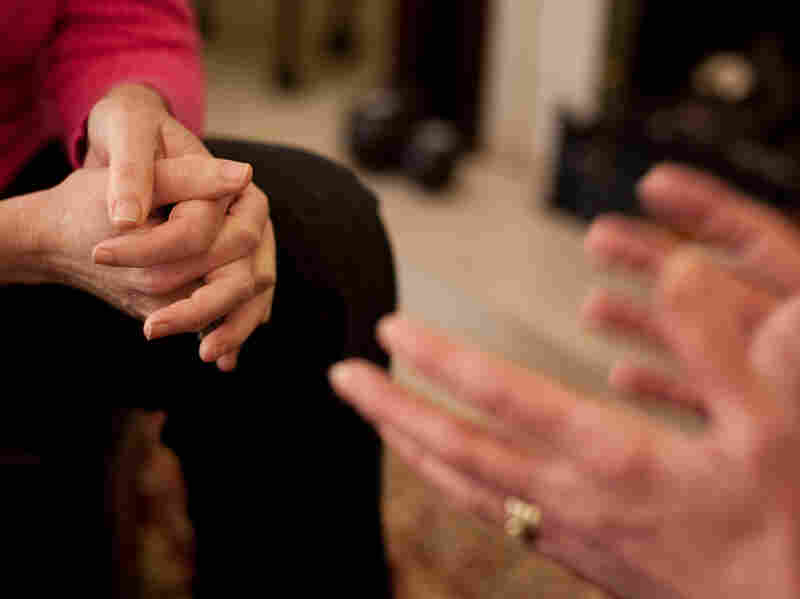Poll: Majority of LGBTQ Americans Report Harassment, Violence Based On Identity
More than half of lesbian, gay, bisexual, transgender and queer Americans say they have experienced violence, threats or harassment because of their sexuality or gender identity, according to new poll results being released Tuesday by NPR, the Robert Wood Johnson Foundation and the Harvard T.H. Chan School of Public Health.
Loading…
“There are very few nationally representative polls of LGBTQ people, and even fewer that ask about LGBTQ people’s personal experiences of discrimination,” says Logan Casey, deputy director of the survey and research associate in public opinion at the Harvard Chan School. “This report confirms the extraordinarily high levels of violence and harassment in LGBTQ people’s lives.”
Majorities also say they have personally experienced slurs or insensitive or offensive comments or negative assumptions about their sexual orientation. And 34 percent say they or an LGBTQ friend or family member has been verbally harassed in the bathroom when entering or while using a bathroom — or has been told or asked if they were using the wrong bathroom.
Loading…
The poll, conducted earlier this year, looked not only at violence and harassment but also at a wide range of discrimination experiences. We asked about discrimination in employment, education, in their interactions with police and the courts and in their everyday lives in their own neighborhoods. We’re breaking out the results by race, ethnicity and identity. You can find what we’ve released so far on our series page “You, Me and Them: Experiencing Discrimination in America.”
We asked whether people see discrimination more as a one-on-one personal-prejudice issue or whether discrimination in laws or government is the larger problem.
We found a sizable age gap. People born after about 1967 saw the world in mostly the same way, but older LGBTQ adults much more frequently said one-on-one prejudice is the larger problem, by a wide margin.
Loading…
“This finding highlights how life experiences and political socialization can really shape how an individual, or a generation of people, thinks about how to create change,” Casey says. “Older generations of LGBTQ people came of age at a time when legal protections were nearly unthinkable and activists agitated in mass scale social movements. But younger people have grown up in the era of gay marriage, ‘don’t ask, don’t tell,’ and employment protections, and more successfully petitioning for rights through judicial or legislative processes.”
The survey finds a big racial gap in the LGBTQ community — LGBTQ people of color reported substantially more discrimination because they are LGBTQ than whites when applying for jobs or interacting with the police.
Loading…
LGBTQ people of color are six times more likely to say they have avoided calling the police (30 percent) owing to concern about anti-LGBTQ discrimination, compared with white LGBTQ people (5 percent).
Loading…
Our survey found significant levels of discrimination against transgender adults as well. About 1 in 6 LGBTQ people says they’ve been personally discriminated against because of their LGBTQ identity when going to a doctor, and nearly 1 in 5 said they’ve avoided seeking medical care for fear they’d be discriminated against.
Loading…
“Research shows that experiencing discrimination has harmful effects on health,” Casey says. “That’s an implication all the more troubling because the poll also shows the serious barriers to health care for LGBTQ and especially transgender people in America.”
Indeed, some 31 percent of transgender people told us they do not have regular access to a doctor or health care. We will broadcast and publish a report later Tuesday on the difficulties transgender people face in seeking health care, particularly in the face of discrimination.
Our results also illustrate the great diversity in identities within what’s called the “LGBTQ community.” For example, to be queer does not necessarily mean one is gay or lesbian. Nor does being transgender mean someone is necessarily gay, lesbian or bisexual. In this chart, we compare cisgender and transgender people based on their self-identified sexual orientation.
Loading…
Additionally, our poll found that among all transgender and gender nonconforming people, 24 percent identify as transgender men, 52 percent identify as transgender women and 25 percent identify as genderqueer or gender nonconforming. More than half (56 percent) of the 86 transgender people in our survey say they are heterosexual.
Overall, our survey found 1.4 percent of Americans identify as transgender, genderqueer and gender nonconforming. A June 2016 survey by the Williams Institute found that 0.6 percent of the adult U.S. population identifies as transgender but did not establish estimates for genderqueer or gender nonconforming adults.
The overall poll results for LGBTQ adults are based on a nationally representative probability-based telephone (cell and landline) sample of 489 LGBTQ adults, including people who are genderqueer and gender nonconforming. The margin of error for total LGBTQ respondents is plus or minus 6.6 percentage points at the 95 percent confidence level.
Our ongoing series “You, Me and Them: Experiencing Discrimination in America” is based in part on a pollby NPR, the Robert Wood Johnson Foundation and the Harvard T.H. Chan School of Public Health. We have previously released results for African-Americans, Latinos, whites and Native Americans. In coming weeks, we will release results for Asian-Americans and women.











